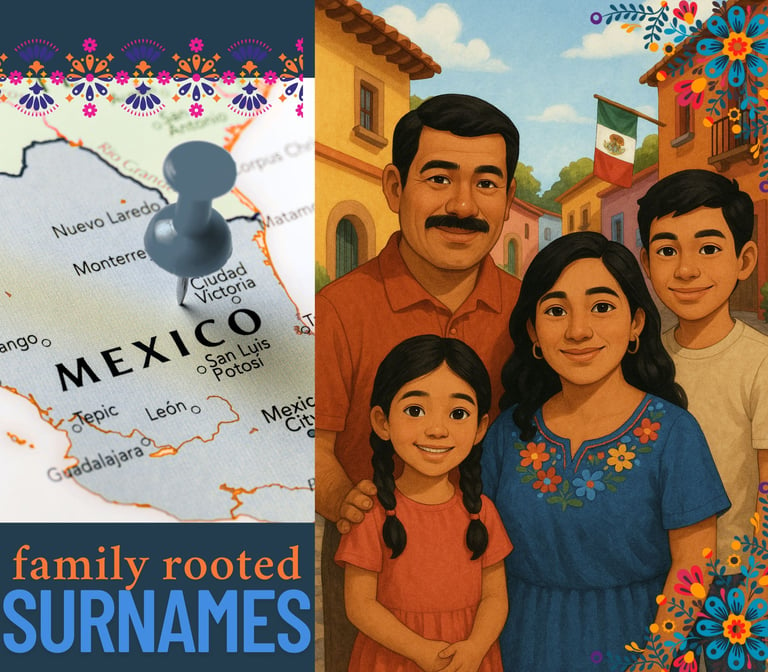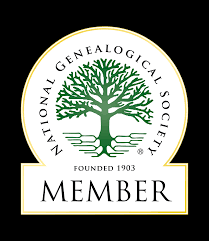In Every Name, a Family Story: Understanding Mexican Surnames
Have you ever looked at a Mexican name and wondered why it seems to tell a longer story than your own? That’s because it does. In Mexico, names are more than just identifiers. They carry heritage, love, and respect for both sides of the family. The tradition of using two last names, passed down from both the father and the mother, reflects a deep cultural value that recognizes our identity as being shaped by everyone who came before us. This meaningful naming custom not only honors ancestry but also makes tracing family history more accessible. In this post, we’ll explore how the tradition began, why it matters, and how it continues to shape generations today.
-Aimee Rose-Haynes
7/19/20254 min read


Why Do Mexicans Have Two Last Names?
A Tradition Rooted in Heritage, Law, and Identity
If you have ever met someone from Mexico and wondered why their name seems twice as long as yours, you are not alone. At first, having two last names might seem confusing, or perhaps like a bureaucratic hassle. But in Mexico, as in many Spanish-speaking countries, this tradition carries deep cultural significance. It is not just a naming convention; it is a tribute to family legacy, a recognition of both maternal and paternal lines, and a symbol of individual identity.
The Basics of Spanish Naming Customs
In English-speaking countries, a person usually has one surname. In contrast, Spanish naming customs use two surnames, known as apellidos. The structure is simple: a person’s full name includes their given name, followed by their father’s first surname, and then their mother’s first surname. For instance, if Jose Flores Ramírez and María García Sanchez have a son named Juan, his full name would be Juan Flores García. This format ensures that both sides of the family are acknowledged and remembered.
Women in Mexico do not change their surnames after marriage. Unlike the common practice in many English-speaking countries where a woman takes her husband's surname, in Mexico, women typically retain the surnames they were given at birth throughout their lives. Some women might socially attach their husband’s surname using the preposition de (meaning "of"), such as María García de Pérez, but this is not a legal requirement and does not replace her original names.
A Genealogist’s Dream
This dual-surname system is extremely valuable in family history research. When you know an ancestor’s full name, you also have access to two important surnames: their father’s paternal surname and their mother’s paternal surname. This allows researchers to trace both sides of a family more easily, even when few records exist. It creates immediate links between generations and extended families, helping to connect distant branches of a family tree that might otherwise remain hidden. In a world where tracing maternal lines can be especially difficult, this tradition offers a unique advantage.
A Tradition with Complex Origins
This two-surname practice can be traced back to Spain and was shaped by both religious and legal developments. Before surnames were standardized, people were often identified using only their first name and the names of their parents. A typical church record might list someone as “Gabriel, son of Perdro and Teresa.”
Everything changed after the Council of Trent in the 16th century. The Catholic Church began requiring detailed documentation of baptisms, marriages, and deaths. These records became especially important during the Spanish Inquisition, when authorities used genealogical records to investigate ancestry and uncover any non-Christian lineage. Individuals with Jewish or Muslim heritage, particularly those who had been forced to convert were closely scrutinized. The church and government began tracking family lines across multiple generations to ensure religious “purity.” This led to the practice of recording all four grandparents' surnames and reinforced the idea that one’s identity was shaped by the entire family tree, not just the father’s name.
Wealthy and noble families were especially conscious of the prestige linked to surnames. Names associated with land, titles, or political status were emphasized to affirm social standing. But this tradition also had practical value. In communities where many people shared the same first names, the dual-surname system helped avoid confusion and offered a clearer way to distinguish individuals.
From Church Records to Civil Registries
By the 19th century, civil registries began to replace church records as the official method for documenting births, marriages, and deaths. Liberal reforms aimed to shift authority from religious institutions to the state. The first civil registry was established in Madrid in 1822, and the process soon expanded across Spain and Latin America. In Mexico, civil registration, which includes birth, marriage, and death records, was established by President Benito Juárez in 1859 but didn't become widespread until after the restoration of the republic in 1867. There was initial resistance from those accustomed to registering vital events with the Catholic Church.
In 1889, Spain passed a national civil code that officially formalized the practice of using both the father’s and mother’s surnames. Mexico and other Spanish-speaking countries adopted similar systems, and the tradition continues to this day.
Challenges in a Global World
While this naming system offers many benefits, it can be difficult to navigate outside of Spanish-speaking countries. In many places, legal and administrative forms only allow for one surname. This limitation can lead to confusion, lost documents, or mismatched records. People might drop their second surname for simplicity, only to encounter problems when their full legal name is required. In some systems, the first apellido may be mistaken for a middle name, or the second apellido might disappear altogether. Others find themselves forced to hyphenate the two names to preserve both.
A Modern Shift Toward Equality
In 2016, Mexico’s Supreme Court ruled that it was unconstitutional to require a father’s surname to come first on a child’s birth certificate. The court recognized that this practice reinforced gender inequality. Parents were granted the right to choose the order of the surnames for their children. A year later, a couple successfully registered their child using both maternal surnames, setting an important legal precedent.
This ruling also gave adults the ability to request a change in the order of their own surnames, allowing for greater personal choice in how individuals present and preserve their identities.
More Than Just a Name
In the end, Mexico’s two-surname tradition is more than a legal formality. It is a cultural expression of respect for both sides of one’s family and a reminder that identity is inherited from more than just one parent. It tells the story of ancestry, social change, and resilience. And for genealogists, it is a powerful tool for tracing lineage and preserving family connections. So the next time you meet someone with a name like Juan Diaz Lopez, remember that it honors generations of history, and ensures that no Juan is ever just another name in the crowd.




